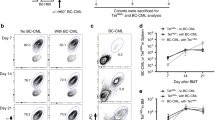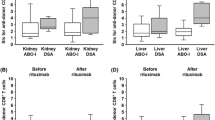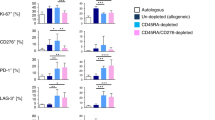Summary:
The immune system of females is capable of recognizing and reacting against the male-specific minor histocompatibility antigen (mHA), HY. Thus, cytotoxic T-lymphocytes (CTLs) recognizing this antigen may be useful in eradicating leukemic cells of a male patient if they can be generated in vivo or in vitro from a human leukocyte antigen (HLA)-identical female donor. The HLA-A*0201-restricted HY antigen, FIDSYICQV, is a male-specific mHA. Using HLA-A2/HY peptide tetrameric complexes, we reveal a close association between the emergence of HY peptide-specific CD8+ T cells in peripheral blood and molecular remission of relapsed BCR/ABL+ chronic myelogenous leukemia in lymphoid blast crisis in a patient who underwent female-to-male transplantation. Assessment of intracellular cytokine levels identified T cells that produce interferon-γ in response to the HY peptide during the presence of HY tetramer-positive T cells. These results indicate that transplant with allogeneic HY-specific CTLs has therapeutic potential for relapsed leukemia, and that expansion of such T cells may be involved in the development of a graft-versus-leukemia response against lymphoblastic leukemia cells.
This is a preview of subscription content, access via your institution
Access options
Subscribe to this journal
Receive 12 print issues and online access
$259.00 per year
only $21.58 per issue
Buy this article
- Purchase on Springer Link
- Instant access to full article PDF
Prices may be subject to local taxes which are calculated during checkout



Similar content being viewed by others
References
Mutis T, Goulmy E . Hematopoietic system-specific antigens as targets for cellular immunotherapy of hematological malignancies. Semin Hematol 2002; 39: 23–31.
Mutis T, Gillespie G, Schrama E et al. Tetrameric HLA class I-minor histocompatibilty antigen peptide complexes demonstrate minor histocompatibility antigen-specific cytotoxic T lymphocytes in patients with graft-versus-host disease. Nat Med 1999; 5: 839–842.
Kern F, Surel IP, Brock C et al. T-cell epitope mapping by flow cytometry. Nat Med 1998; 4: 975–978.
Kuzushima K, Hoshino Y, Fujii K et al. Rapid determination of Epstein–Barr virus-specific CD8+ T-cell frequencies by flow cytometry. Blood 1999; 94: 3094–3100.
Meadows L, Wang W, den Haan JM et al. The HLA-A*0201-restricted H-Y antigen contains a post translationally modified cysteine that significantly affects T cell recognition. Immunity 1997; 6: 273–281.
Kondo Y, Shiobara S, Nakao S . Identification of T-cell clones showing expansion associated with graft-versus-leukemia effect on chronic myelogenous leukemia in vivo and in vitro. Exp Hematol 2001; 29: 471–476.
Verdijk RM, Mutis T, Wilke M et al. Exclusive TCRVbeta chain usage of ex vivo generated minor histocompatibility antigen HA-1 specific cytotoxic T cells: implications for monitoring of immunotherapy of leukemia by TCRBV spectratyping. Hematol J 2002; 3: 271–275.
Kuzushima K, Hayashi N, Kudoh A et al. Tetramer-assisted identification and characterization of epitopes recognized by HLA A*2402-restricted Epstein–Barr virus-specific CD8+ T cells. Blood 2003; 101: 146–1468.
Redchenko IV, Rickinson AB . Accessing Epstein–Barr virus-specific T-cell memory with peptide-loaded dendritic cells. J Virol 1999; 73: 334–342.
Nakao S, Takami A, Takamatsu H et al. Isolation of a T-cell clone showing HLA-DRB1*0405-restricted cytotoxicity for hematopoietic cells in a patient with aplastic anemia. Blood 1997; 89: 3691–3699.
Chomczynski P, Sacchi N . Single step method of RNA isolation by acid guanidium thiocyanate phenol–chloroform extraction. Anal Biochem 1987; 162: 156–159.
Currier JR, Deulofeut H, Barron KS, Kehn PJ, Robinson MA . Mitogens, superantigens, and nominal antigens elicit distinctive patterns of TCRB CDR3 diversity. Hum Immunol 1996; 48: 39–51.
Waase I, Kayser C, Carlson PJ et al. Oligoclonal T cell proliferation in patients with rheumatoid arthritis and their unaffected siblings. Arthritis Rheum 1996; 39: 904–914.
Casanova JL, Pannetier C, Jaulin C, Kourilsky P . Optimal conditions for directly sequencing double-stranded PCR products with sequenase. Nucleic Acids Res 1990; 18: 4028.
Goulmy E, Schipper R, Pool J et al. Mismatches of minor histocompatibility antigens between HLA-identical donors and recipients and the development of graft-versus-host disease after bone marrow transplantation. N Engl J Med 1996; 334: 281–285.
Maruya E, Saji H, Seki S et al. Evidence that CD31, CD49b, and CD62L are immunodominant minor histocompatibility antigens in HLA identical sibling bone marrow transplants. Blood 1998; 92: 2169–2176.
Marijt WA, Heemskerk MH, Kloosterboer FM et al. Hematopoiesis-restricted minor histocompatibility antigens HA-1- or HA-2-specific T cells can induce complete remissions of relapsed leukemia. Proc Natl Acad Sci USA 2003; 100: 2742–2747.
Gratwohl A, Hermans J, Niederwieser D et al. Female donors influence transplant-related mortality and relapse incidence in male recipients of sibling blood and marrow transplants. Hematol J 2002; 2: 363–370.
Mutis T, Verdijk R, Schrama E et al. Feasibility of immunotherapy of relapsed leukemia with ex vivo-generated cytotoxic T lymphocytes specific for hematopoietic system-restricted minor histocompatibility antigens. Blood 1999; 93: 2336–2341.
Gallardo D, Arostegui JI, Balas A et al. Disparity for the minor histocompatibility antigen HA-1 is associated with an increased risk of acute graft-versus-host disease (GvHD) but it does not affect chronic GvHD incidence, disease-free survival or overall survival after allogeneic human leucocyte antigen-identical sibling donor transplantation. Br J Haematol 2001; 114: 931–936.
Teshima T, Ordemann R, Reddy P et al. Acute graft-versus-host disease does not require alloantigen expression on host epithelium. Nat Med 2002; 8: 575–581.
Becker C, Pohla H, Frankenberger B et al. Adoptive tumor therapy with T lymphocytes enriched through an IFN-gamma capture assay. Nat Med 2001; 7: 1159–1162.
Nazaruk RA, Rochford R, Hobbs MV, Cannon MJ . Functional diversity of the CD8+ T-cell response to Epstein–Barr virus (EBV): implications for the pathogenesis of EBV-associated lymphoproliferative disorders. Blood 1998; 91: 3875–3883.
Acknowledgements
This work was supported by a Grant-in-Aid for Scientific Research from the Ministry of Health, Labor and Welfare. We wish to thank Megumi Yoshii for the excellent technical assistance as well as her patience in preparation of the manuscript.
Author information
Authors and Affiliations
Corresponding author
Rights and permissions
About this article
Cite this article
Takami, A., Sugimori, C., Feng, X. et al. Expansion and activation of minor histocompatibility antigen HY-specific T cells associated with graft-versus-leukemia response. Bone Marrow Transplant 34, 703–709 (2004). https://doi.org/10.1038/sj.bmt.1704583
Received:
Accepted:
Published:
Issue Date:
DOI: https://doi.org/10.1038/sj.bmt.1704583



